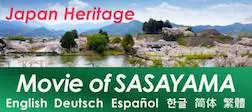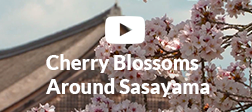High-Quality Tamba Ware at Tachikui Sue no Sato
In Tamba Sasayama, be sure to visit Tachikui Sue no Sato. In this village, where you can find traditional Tamba ware, one of Japan’s six ancient kilns, and maybe even get involved in pottery making yourself.
Tamba ware began to be made in the Tamba Sasayama area between the end of the Heian Period (794-1185) and the beginning of the Kamakura Period (1185-1333). This craft boasts over 800 years of history.
At the very beginning, this type of pottery was called Onohara ware. An older type of kiln, made by digging a hole in the hillside, was used for making this pottery. However, in the 17th century, a climbing kiln was introduced from the Korean Peninsula. In 1878, this type of ware was added to the list of Japan’s traditional pottery types under the name of Tamba-Tachikui ware.
The distinctive feature of Tamba ware is the use of the climbing kiln. Due to the extremely high temperature, the ash made from burning pine firewood dances all around the inner part of the kiln, mixing the glaze covering the pottery. The result is various extraordinary patterns on the surface of the pottery.
This variation in color and patterns is what makes Tamba ware so extraordinary. Its simple and moderate beauty ought to stand out even more when put to everyday use, in your kitchen, or on the table.
Nevertheless, making pottery isn’t the only thing one can do at Tachikui Sue no Sato. The area boasts beautiful scenery and there are various destinations around for field trips! You can also admire famous art pieces made during the Edo Period (1603-1868) or the “ancient Tamba,” how it is referred to, as well as artwork by contemporary artisans.

Try Your Hand at Making Pottery at Tachikui Sue no Sato!
You can try several activities here. How about making your own piece of Tamba ware at a pottery class? (A separate fee required.) Visitors can also learn about kiln technology, the firing process, and pottery-making by joining the kiln-studying and observing tour.
During the pottery class, you can choose between making Tamba ware from scratch and decorating a piece of pottery.
If you feel like making your own pottery art, you will start by kneading the clay first. There is no need to feel nervous or ashamed if you’re a beginner - there is a teacher present to offer support and guide you through the process in detail. In other words, even amateurs will have fun. The best part is the anticipation of your finished artwork!
You just have to give it the last touch in order to feel completely satisfied with how it looks, and then - leave it to the professionals. It will be delivered to your address in about two months.
Decorating a piece of pottery is another way to have fun and show the world your creative side. Your task is to draw some patterns with a paintbrush on a piece of pottery. This is a great way to surprise your beloved ones with a personal, handmade gift, don’t you think?
This unique opportunity to make pottery in Tamba Sasayama, surrounded by beautiful nature, is bound to become a wonderful memory.
During the kiln observation tour, visit some of the 52 kilns existing in this area. Look at the pottery pieces and find the one that speaks to you the most.
Visitors to the area can also partake in gatherings, festivals, and other activities organized each season in the courtyard of the facility.

Tamba Traditional Ware Park Tachikui Sue no Sato
Address: Sasayama, Konda, Kami-Tachikui 3
Phone number: 079-597-2034
Website: https://tanbayaki.com/english/english.html
Access: take the Shinki Bus bound for Kiyomizu, or the Shinki bus bound for Hyogo Museum of Ceramic Art from Aino Station of JR Fukuchiyama Line, then get off at Sue-no-Sato-Mae bus stop; or get off at Tachikui-Kokaido-Mae bus stop, then walk for 5 minutes.
Price: admission fee for high school students and older is 200 yen (for groups including more than 20 people, the price is 160 yen); for elementary school students and middle-high school students, the fee is 50 yen (no discount for groups); the pottery-making activity is not included in the price (for more information on the fees, please visit the official homepage).
Holidays: from December 29 to January 1.



